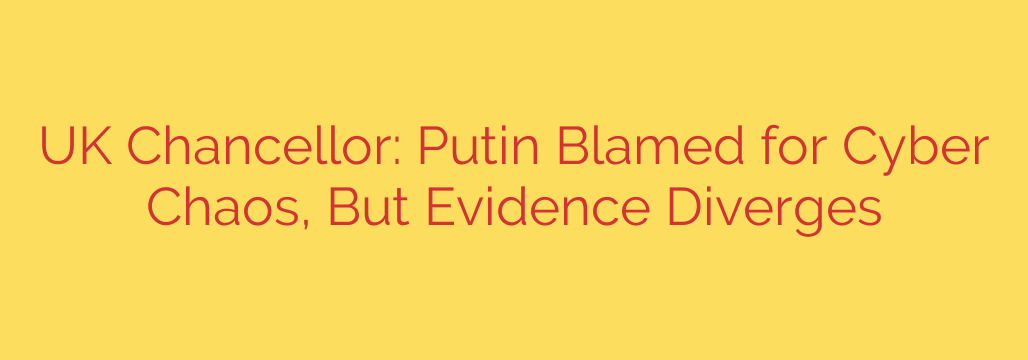
Unmasking the Culprits of Global Cyber Chaos: Beyond the Usual Suspects
In an increasingly digitized world, the escalating frequency and sophistication of cyber attacks have become a critical concern for governments, businesses, and individuals alike. High-level officials often point the finger at a handful of state actors, with Russia frequently cited as a primary source of global cyber disruption. While this attribution holds some truth, a deeper look reveals a far more complex and multifaceted threat landscape.
Focusing on a single adversary can dangerously oversimplify the reality of modern cyber warfare. To truly understand the risks we face, we must look beyond the headlines and examine the diverse array of actors and motivations driving these digital assaults.
The Reality of State-Sponsored Hybrid Warfare
It is undeniable that certain nations have integrated cyber operations into their military and geopolitical strategies. This approach, often called hybrid warfare, blends conventional military actions with covert cyber attacks, disinformation campaigns, and economic pressure. The goal is to destabilize adversaries from within, targeting everything from political processes to essential public services.
Key targets of these state-sponsored attacks often include:
- Critical National Infrastructure: Energy grids, water supplies, transportation networks, and healthcare systems are prime targets due to the potential for widespread public disruption.
- Financial Systems: Attacks on banks, stock exchanges, and financial regulators aim to sow economic chaos and undermine confidence in a nation’s economy.
- Government and Defense Networks: Espionage and data theft are constant threats, as nations seek to gain intelligence and a strategic advantage over their rivals.
While Russia has been prominently linked to such activities, especially in the context of conflicts like the war in Ukraine, it is crucial to recognize they are not the only player on this digital battlefield.
A More Complex Picture: The Diverse Threat Actors
The evidence shows that a broader coalition of state and non-state actors is actively engaged in malicious cyber activities, each with distinct motivations and methods.
- China: Often associated with large-scale economic espionage, cyber operations linked to China frequently target corporations to steal intellectual property, trade secrets, and proprietary research, aiming to bolster their own economic and technological prowess.
- North Korea: Facing heavy international sanctions, North Korea has reportedly turned to cybercrime as a key source of state revenue. Their operations often focus on financial theft, including sophisticated heists on cryptocurrency exchanges and banks, to fund their weapons programs.
- Iran: Cyber activities linked to Iran are often seen as retaliatory or aimed at furthering regional geopolitical goals. Their attacks can range from disruptive campaigns against rivals to espionage and influence operations.
This diversification of threats means that a one-size-fits-all defense strategy is no longer sufficient. Organizations must understand the different tactics and objectives of each potential adversary.
The Blurring Lines Between Cybercriminals and States
Perhaps the most significant development in recent years is the murky relationship between nation-states and independent cybercriminal gangs. Ransomware groups, for example, often operate with a degree of tacit approval or impunity from within the borders of certain nations, as long as their attacks are directed outward.
This creates a convenient layer of deniability for the host country while allowing them to benefit from the disruption caused. The rise of Ransomware-as-a-Service (RaaS) has further democratized this threat, allowing less sophisticated criminals to lease powerful attack tools, making it even harder to attribute an attack to a specific group or nation.
Fortifying Your Defenses: Actionable Steps to Mitigate Cyber Risks
In this era of persistent and varied cyber threats, a proactive and layered defense is essential. Waiting to react to an attack is a losing strategy. Businesses and organizations must take immediate steps to harden their security posture.
Adopt a Zero-Trust Security Model: The old perimeter-based security model is obsolete. A zero-trust architecture operates on the principle of “never trust, always verify.” It requires strict identity verification for every person and device trying to access resources on a network, regardless of whether they are inside or outside the network perimeter.
Implement Multi-Factor Authentication (MFA): One of the single most effective security measures, MFA adds a critical layer of protection beyond just a password. By requiring a second form of verification, it can thwart the vast majority of credential theft attacks.
Prioritize Regular Employee Training: Your employees are both your greatest asset and a potential vulnerability. Continuous security awareness training is vital to teach them how to recognize and report phishing emails, social engineering attempts, and other common attack vectors.
Maintain a Robust Patch Management Program: Many successful cyber attacks exploit known vulnerabilities for which a patch is already available. A disciplined and timely process for applying security updates to all software, systems, and devices is fundamental to good cybersecurity hygiene.
Develop and Test an Incident Response Plan: It is not a matter of if you will face a cyber incident, but when. Having a well-documented and regularly tested incident response plan ensures that you can detect, respond to, and recover from an attack quickly and effectively, minimizing financial and reputational damage.
Ultimately, attributing blame for cyber chaos is a complex geopolitical issue. But for organizations on the front lines, the origin of an attack is less important than the strength of their defense. By understanding the diverse nature of the threat and implementing robust, multi-layered security controls, you can build the resilience needed to operate safely in an increasingly hostile digital world.
Source: https://go.theregister.com/feed/www.theregister.com/2025/09/23/reeves_blames_russia_cyberattacks/








